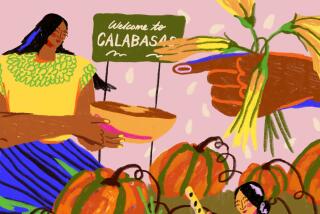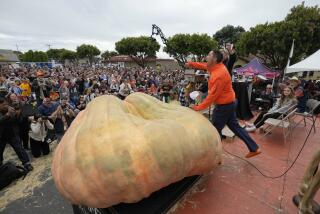A Pumpkin for Every Table
One fine day during the autumn, when we lived in the English countryside, we went into town to choose a pumpkin for our small son’s Halloween. In those days--or at least in those days in that place--Halloween wasn’t a holiday. Still, we were shocked that there wasn’t a pumpkin in all of Henley-on-Thames.
“There’s very little demand for such a large vegetable, Madam,” said our favorite greengrocer. “May I order you one?”
And so he did. I’ll never forget his call a few days later: “Your squash has arrived from London, Madam.”
I was bewildered. Squash? I’d promised our son a pumpkin.
“I beg your pardon?” I said. “Your squash, Madam, your squash.” He began to shout the way people do when someone doesn’t understand them. Then a light bulb went on in my head. Was a pumpkin a sort of winter squash?
Reflecting on this and other pumpkin moments in my life, it occurred to me that it is a something-for-everybody vegetable.
Gardeners with aggressive dispositions can coax pumpkins into heroic proportions. Miniaturists can be beguiled by palm-size pumpkins. For romantics, pumpkins are Cinderella’s coach. For kids, they’re scary or goofy or smiling Halloween jack-o’-lanterns. For traditionalists and appreciators, they are the luscious finishing touch to Thanksgiving dinner. For bakers experimenting beyond pie, cooked caramel-colored pumpkin flesh adds moisture, richness and flavor to a wealth of cakes, breads, muffins, cookies.
If you’re a candy maker or candy fancier, you probably know that pumpkin makes one of the greatest confections in this world. Candied pumpkin is dark as earth yet luminous, with a velvety texture. The best I’ve tasted came from a tiny Mexican grocery in Palm Springs. It inspired me to try my hand at it. I found the making wonderfully conducive to meditation.
For soup makers, pumpkin makes fabulous soup--and a big orange pumpkin shell makes a handsome tureen.
The tureens can come in wonderful shapes. I find the most sensuous those with deep narrow ribs that are flat and round as wheels of cheese, about six inches tall and three times as wide. Illustrators have long drawn fairy tale pumpkins in that shape. An example is Rouge Vif d’Etampes, a very old French heirloom. Rouge vif means vibrant red, and the pumpkin’s shell can be any hue from dark orange to sunset red. The fable of Cinderella comes from 17th Century France, and I like to think this is the pumpkin Cinderella’s fairy godmother sent to her.
Magdalena Big Cheese, also flattened and ribbed, is another magnificent pumpkin with a very different background. It comes from Sonora and is adapted to growing in the low desert. Its shell is orange on the tannish side, filled with delicious thick orange flesh.
Atlantic Giant also has marvelously deep ruffled ribs, but it can get so enormous that it can keel over on its side so the ribs seem to run sideways. This is the cultivar that holds the world’s record for weight: 493 1/2 pounds. It can take a team of horses to pull it from the field, and the orange flesh of one Atlantic Giant makes several hundred good pies.
In contrast is the globe shape that’s slightly flattened at both ends and lightly ribbed. This is the traditional jack-o’-lantern pumpkin. Bright orange Connecticut Field is the classic of this shape, weighing 15 to 25 pounds with thick deep yellow flesh.
*
Seedsmen have developed several “improved” Connecticut Fields. The shapes are more symmetrical and uniform. Why on earth would you want to raise a field of jack-o’-lanterns that all look the same? The pleasure of choosing pumpkins for carving is that you want a tall one for a long, droll face, a fat-cheeked one that will be puckish, a strange one for something demonic. Alas, grocers want pumpkins more symmetrical to make neat displays.
One cultivar that’s so delightful it can be forgiven for being relatively uniform is Baby Bear, developed in Maine by Johnny’s Select Seeds. Less than half the size of most pie pumpkins--1 1/2 to 2 1/2 pounds--Baby Bears are delightfully plump and just the right size for a small child’s jack-o’-lantern. Their vines dry to make sturdy handles when the child wants to cart the jack-o’-lantern around.
In seed catalogues, a strong stem that makes a good handle is sometimes a selling point for a cultivar. Unless you know this to be true of the pumpkins you grow, never pick up a pumpkin by its stem. Often the dried stem will be brittle and not up to the burden of the weight beneath.
*
As for the best pumpkin for pie, since before the Civil War the standard has been the dry, sweet, not-stringy deep orange flesh of Small Sugar (also known as New England Pie). The fruits are round and average seven pounds.
Recently, a couple of ancient forms of pumpkins have been popularized by breeders: minis and ghostly whites.
Set a three-inch Jack-Be-Little on the flat of your hand and you can see an orange coach. The vines are small and vigorous, producing lots of decorative and edible pumpkins.
Devotees of pumpkins with cream-colored shells enjoy the fact that from behind the carving of a jack-o’-lantern, warm orange flesh gleams through. Lumina is fat and almost round, lightly ribbed and 10 to 15 pounds of delicious eating. Cream-colored shells are not uncommon among winter squashes.
To grow pumpkins and winter squashes, give vines full sun and constantly moist, well-drained soil stuffed with organic matter. Seeds are sown in spring in soil that’s warm. If you have frost, sow seeds indoors a week before the last expected frost date.
*
I set pumpkins three feet apart at the edge of the border, so they can amble over the grass or along the railroad ties or down the slope. When the plants show signs of growing, mulch them deeply with compost. Spray once a month with mild kelp solution.
In small gardens, you can grow one pumpkin plant in lightweight potting mix in a five- to six-gallon container two feet deep--or send vines of mini-pumpkins up a fence or trellis.
Always handling them gently, harvest pumpkins before autumn’s first frost (should frost take you by surprise, cover them). Fruits won’t ripen off the vine, so wait until the stalks begin to shrivel and the shell is no longer shiny and can’t be pierced with a thumbnail.
Leave at least an inch of stem on the pumpkin when you cut it, or six to seven inches if you know the handle will be strong. Cure the pumpkin in the sun for one to three days, then wipe with a very dilute bleach solution. Store pumpkins at 50 to 60 degrees in a dark airy place and check occasionally for spoilage. Pepos can last three months, maximas up to a year.
All the pumpkins I’ve mentioned are non-hybrid strains, and if you sow their seeds, they’ll breed true. Bear in mind that as one strain of a cultivar develops in a particular place, some characteristics emerge and some may vanish. For example, one catalogue offering Rouge Vif d’Etampes says it’s “more for decoration than for eating” and another says its “thick rich flesh is eaten like a winter squash.” The flesh of one company’s Lumina is “bright orange,” another’s is “golden.”
Don’t think this is a matter of language; take them literally.
More to Read
Eat your way across L.A.
Get our weekly Tasting Notes newsletter for reviews, news and more.
You may occasionally receive promotional content from the Los Angeles Times.









